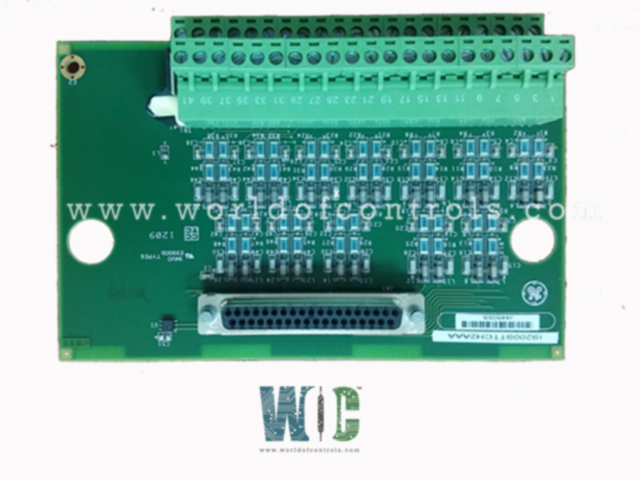SPECIFICATIONS
Part Number: IS200STTCS1A
Manufacturer: General Electric
Series: Mark VIeS
Product Type: Simplex Thermocouple Input Terminal Board
Maximum Lead Resistance: 15 ohm
Analog output current: 0-20 mA
Size: 15.9 cm high x 17.8 cm wide
Frequency: 50 or 60 Hz
Repair: 3-7 Day
Availability: In Stock
Country of Manufacturer: United States
Manual: GEH-6725R
Functional Description
IS200STTCS1A is a Simplex Thermocouple Input Terminal Board developed by General Electrics. The STTC terminal board is a compact model suitable for DIN-rail or flat mounting. It features 12 thermocouple inputs and links to the PTCC thermocouple processor board on Mark VIe or VTCC thermocouple processor board. It shares the same signal conditioning and cold junction reference as the larger TBTC board. High-density Euro-Block terminal blocks (two options) are fixed on the board. An embedded ID chip enables the processor to identify the board for diagnostic use.
Features
- Input: The board has multiple input terminals where you can attach the wires from the thermocouples. Each thermocouple typically consists of two different metal wires, and the junction of these wires is where the temperature is measured.
- Cold Junction Compensation: The Simplex board usually includes a cold junction compensation circuit. This is essential because the reference junction (where the thermocouple wires connect to the board) is not at the same temperature as the actual measurement point. The board compensates for this temperature difference to provide an accurate temperature reading.
- Signal Conditioning: Once the thermocouple signals are received at the input terminals, the board may perform signal conditioning. This involves amplification and filtering to ensure a robust and reliable signal that can be read by the connected measurement or control system.
- Output: The board usually provides an output that can be connected to a data acquisition system, temperature controller, or other devices that require temperature data.
- Calibration: To maintain accuracy, periodic calibration of the Simplex Thermocouple Input Terminal Board may be necessary. Calibration ensures that the temperature readings correspond correctly to the actual temperatures being measured.
Operation
- The connection process of the STTC involves linking it to the I/O pack or board housing the A/D converter. This specific I/O pack or board plays a crucial role by delivering the necessary excitation for the cold junction (CJ) reference located on the board.
- Within this configuration, there are 12 distinct thermocouple signals that are transmitted, along with the Cold Junction (CJ) signal. Additionally, the connection to the identity chip (ID) is established as part of the communication. These various signals and connections are routed through connector JA1, which serves as the conduit for data exchange between the terminal board and the corresponding I/O pack or board containing the A/D converter.
Product Attributes
- Designed to accommodate a total of 12 channels per board, allowing for the simultaneous connection of multiple sensors or inputs. This flexibility makes it a versatile solution for various applications. It supports a wide range of thermocouple types, including E, J, K, S, T thermocouples, as well as mV inputs, catering to diverse measurement requirements.
- When it comes to the span of measurement, the STTC terminal board covers a broad range, specifically from -8 mV to +45 mV. This extensive span ensures the board's capability to capture a wide spectrum of input signals, facilitating accurate and comprehensive data acquisition.
- To ensure precision and accuracy, the terminal board incorporates a cold junction compensation mechanism. The reference junction temperature is meticulously measured at a single location, ensuring consistent and reliable compensation for any temperature-related variations. This meticulous attention to cold junction compensation contributes to the overall accuracy of the measurements obtained through the terminal board.
- In terms of cold junction temperature accuracy, the terminal board maintains a high level of precision. The cold junction accuracy is rated at -17 degrees Celsius (2 degrees Fahrenheit). This exceptional accuracy minimizes potential errors and discrepancies that may arise due to temperature variations, enabling users to rely on the terminal board's measurements with confidence.
WOC has the largest stock of Speedtronic control spares. Please contact our staff by phone or email for pricing and availability on any parts and repairs
FREQUENTLY ASKED QUESTIONS
What is IS200STTCS1A?
It is a Digital Interface Board developed by General Electrics
How does the Simplex Thermocouple Input Terminal Board work?
The board receives signals from the thermocouples at its input terminals. It compensates for the temperature difference between the reference junction and the measurement point (cold junction compensation) to provide accurate temperature readings. The board may also perform signal conditioning to amplify and filter the signals before outputting them to the connected devices.
What happens if a thermocouple type exceeds its hardware limits?
When a thermocouple type surpasses its hardware limits, it triggers a logic signal, and the input is halted from being scanned. This mechanism ensures that potentially erroneous data is not used in further processing.
How are composite diagnostic alarms generated from hardware limits?
When any of the inputs' hardware limits are activated, a composite diagnostic alarm is generated. This indicates that multiple thermocouple types have breached their limits, prompting attention due to abnormal conditions.
How is the terminal board connector uniquely identified?
Each terminal board connector possesses its own identification (ID) device. This ID device is queried by the I/O board to determine the specifics of the connected terminal board.
